On April 22, 2010, The Wall that Heals, which is a scaled down replica of the Vietnam War Monument on the Mall in Washington, DC, came to the Veterans Park in Washington, NC. The traveling ½ scale replica of the novel and impactful Vietnam War Memorial in the United States’ capitol was presented to this eastern North Carolina region in the Veteran‘s Park, along the duck and goose inhabited shores of Jack’s Creek in the inner city of this county seat of Beaufort County.
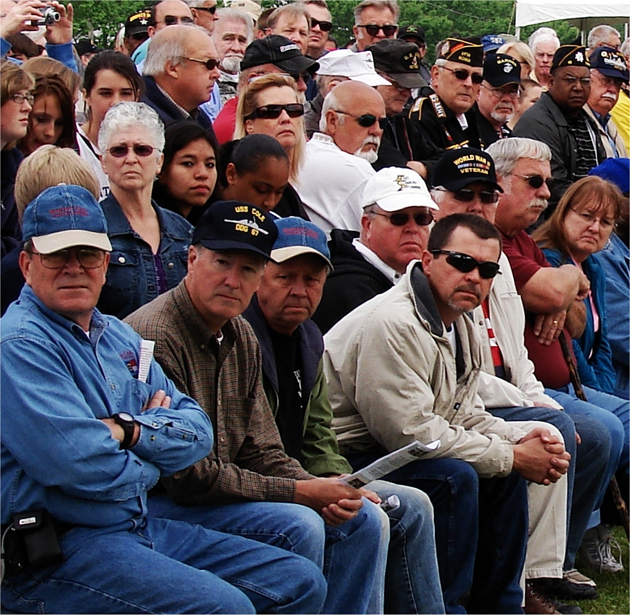
The diminutive wall exhibition was escorted by the motorcycle club Patriot Guard Riders, who hail from Danville, Virginia. The ceremony initiating the Washington exhibition, which ran from Thursday, April 22, through Sunday, April 25, was well attended by veterans from all over the region, as was exhibited by the commemorative caps worn by our heroes, who live among us, who have fought our wars. And while the roving memorial commemorates the region’s 42 Vietnam War heroes, who paid the ultimate sacrifice with their lives, I believe the wall is equally about those veterans from our nation’s wars who survived.
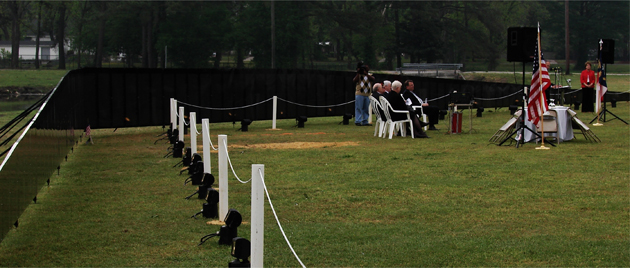
The replica of the scaled down with dignitaries sitting in front of the wall, waiting to speak: Above. George H. Schryer served admirably as the master of ceremonies: Below.
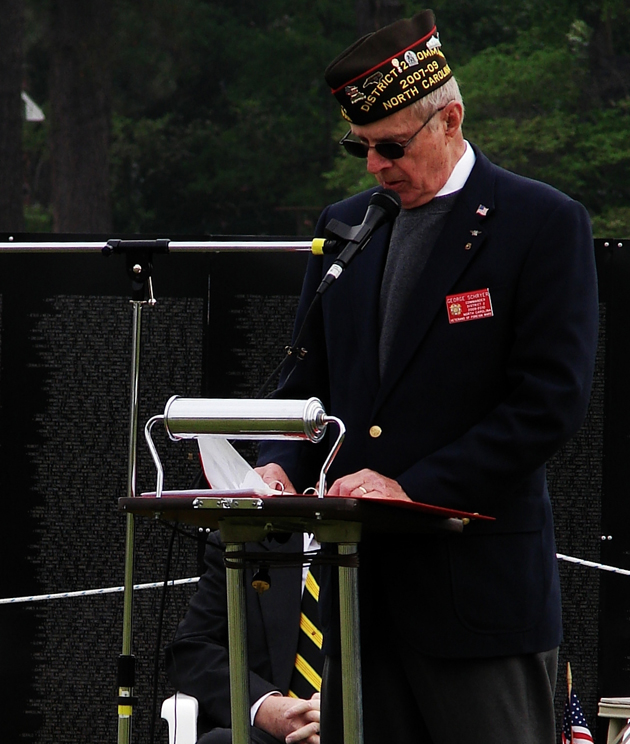
A number of these veterans spoke on that overcast Thursday before a large crowd spilling well over the portable viewing stands to the standing-room-only throng, which numbered well into the upper hundreds. Vietnam War era Marine Chaplain Bob Paciocco opened the service with a pray, and spoke of ministering to 400 of these names memorialized as inscribed upon that traveling wall. Chaplain Paciocco spoke of his replacement, Navy Chaplain Vincent Capodanno, when he rotated back home.
Father Capodanno, when detached to the 1st Battalion 5th Marines near the village of Dong Son, was killed while his company of Marines was engaged in a battle with North Vietnamese Regulars in far superior numbers. As great numbers of these marines lay dead and near death, Father Capodanno continued to minister the last rites to his marines as the battle raged on and the Chaplain’s body riddled by enemy fire. Father Capuano perished from his mortal wounds, and was awarded, posthumously, our nation’s highest honor - the Congressional Medal of Honor for the gift of for his compassionate valor.
Another Congressional Medal of Honor winner that was present for this solemn ceremony was Colonel Walter Joseph Marm, Jr., retired, who was the keynote speaker. The Colonel spoke of the dedication of this site along Jack’s Creek as temporary hallowed ground as if it was an allegorical representation of our acknowledgement to those dedicated men, who served our nation to save Viet Nam from itself.
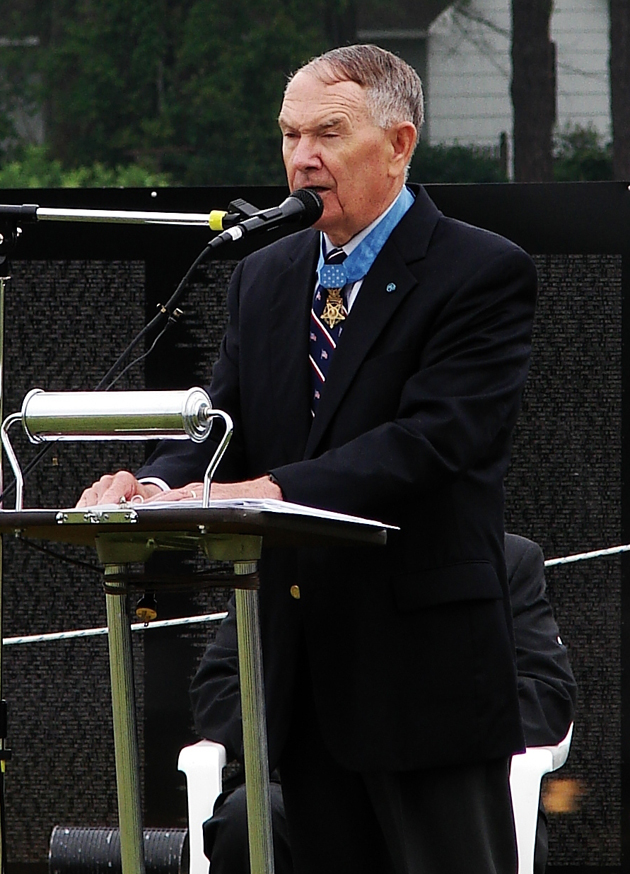
Medal of Honor awardee Colonel Walter Joseph Marm, Jr. spoke of the honor of those good men inscribed upon that wall. Col. Marm received the nation's highest honor for his heroism in the Battle of Ia Drang, which was popularized by the book "We Were Soldiers and Young," and the film "We Were Soldiers." The then second lieutenant served under Lt. Col. Hal Moore, who was portrayed by Mel Gibson: Above. Accompanying the "Wall" is a trailer that displays a short museum of sorts of the Vietnam War soldiers' heroism: Below.
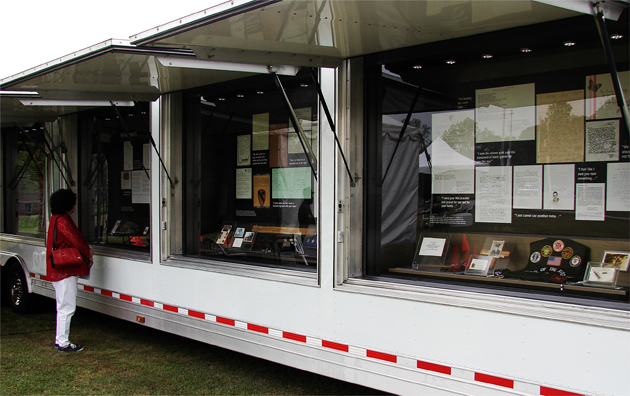
Colonel Marm knew well of such dedication at the Battle of Ia Drang on November 14-18, 1965, where he was wounded, when, as a 1st Lieutenant, he led his platoon against an overwhelming enemy force to save another surrounded platoon. During his platoon’s assault to break the enemy’s stranglehold on the surrounded platoon, Lt. Marm exposed himself at great risk, and using whatever ordinance he could gather, killed 12 of the enemy, including the destruction of the concealed machine gun position that had pinned down his platoon, and kept them at great peril.
Hearing the Colonel, who was willing to lay down his life so that his men could survive in the valley of Ia Drang, deliver his eulogy of those men, who paid the ultimate sacrifice under the direst circumstances, carried an extraordinary weight. His words bore the gravity all men lost in America’s wars, not just those immortalized within scribed names upon that hallowed Wall. And in that moment, one understands the enormity of the American soldier’s universal commitment to the preservation of peace that a nation and its people must endure to remain free. That there are those soldiers, whose names will remain on that memorial, who lost their lives at seventeen, eighteen, so that we may never know the hell of battle, or exist as a civilian populace under the oppressive yoke of a tyrant is their supreme gift to their fellow man, and we should all be eternally grateful. One of the worst sorrows in our American history is that many of us were not.
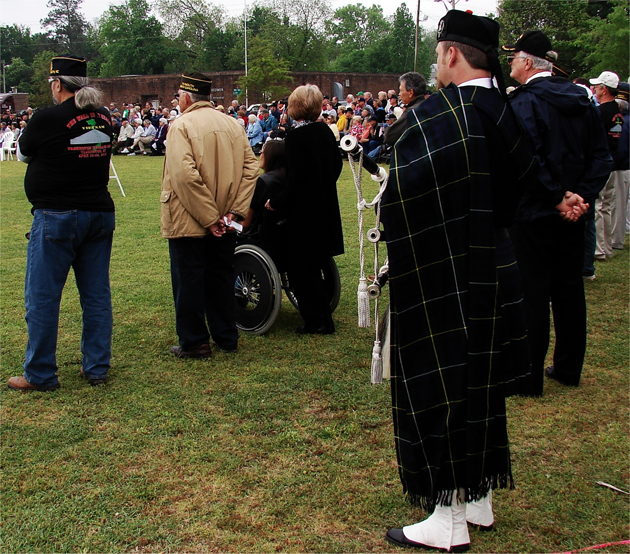
The ceremony for the was made more colorful by the bagpipes: Above. They were designated as solemn by the signs: Below.

As war escalated in late 1965 with the Battle of Ia Drang, which began the push to alleviate the South Vietnam of the Vietcong, to the fierce fighting of the Tet Offensive that began January 21, 1968, when 80,000 North Vietnamese regulars crossed the DMZ, separating North from South Vietnam, to link up with the Vietcong, and change the tide of the war for the Communists.
As many of you know who have an inkling of understanding of military history know this did not happen. Our American soldiers - U.S. Army and the Marine Corps - beat the Communist insurgents and the local Vietcong, with kill ratios approaching 40 to 1 at the end of the Tet Offensive. In all 1,536 American soldiers gave their lives in the nearly two months of fierce fighting, and now their names are memorialized on the Wall. The victory of the Tet Offensive was a complete strategic and military success, and could have been the beginning of the rout that would finished the North if we, Americans, could have mustered the will to finish what we had started, but it was to no avail.
CBS News Anchor Walter Cronkite, who was touted by CBS as, ironically, “the most trusted man in America,” did a series of war reports from battle raged South Vietnam, Commentator Cronkite, on February 27, 1968, mustered the impetus to “call the war a stalemate.” And just as many in his profession have, before and since, erroneously called presidential elections way too soon before all these votes were counted: Walter Cronkite “called the war.”
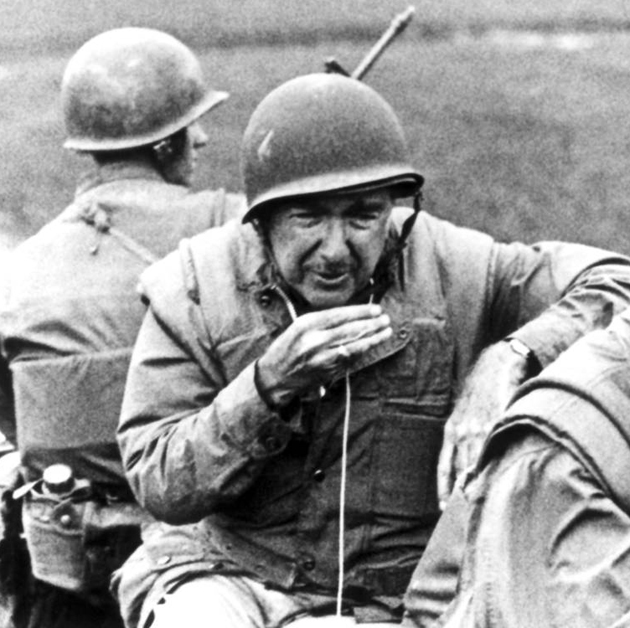
It is recorded that when President Lyndon Johnson heard of Walter Cronkite “calling the war,” he said, “That's it. If I've lost Cronkite, I've lost middle America.” Now it not Cronkite’s fault that Lyndon Johnson was a weak president, but it is his fault that he interjected himself into U.S. policy, especially since he did not posses the capability to understand the machinations of total war. But, then again, neither did President Lyndon Johnson. And that was biggest tragedy of the Vietnam War.
At this infamous point, the antiwar movement was given the fuel it desperately needed with Walter Cronkite’s sophistic assessment of the whole Tet Offensive. Night after night on the evening news, Americans sat glued to the Evening News watching uncensored reports of the carnage from the War countered with the growing protests of college students, and other acts of civil disobedience. With the CBS, and Walter Cronkite, leading the charge it did not take long, at that point, to lose the public’s sentiment to complete the war effort.


 The replica of the scaled down with dignitaries sitting in front of the wall, waiting to speak: Above. George H. Schryer served admirably as the master of ceremonies: Below.
The replica of the scaled down with dignitaries sitting in front of the wall, waiting to speak: Above. George H. Schryer served admirably as the master of ceremonies: Below.

 Medal of Honor awardee Colonel Walter Joseph Marm, Jr. spoke of the honor of those good men inscribed upon that wall. Col. Marm received the nation's highest honor for his heroism in the Battle of Ia Drang, which was popularized by the book "We Were Soldiers and Young," and the film "We Were Soldiers." The then second lieutenant served under Lt. Col. Hal Moore, who was portrayed by Mel Gibson: Above. Accompanying the "Wall" is a trailer that displays a short museum of sorts of the Vietnam War soldiers' heroism: Below.
Medal of Honor awardee Colonel Walter Joseph Marm, Jr. spoke of the honor of those good men inscribed upon that wall. Col. Marm received the nation's highest honor for his heroism in the Battle of Ia Drang, which was popularized by the book "We Were Soldiers and Young," and the film "We Were Soldiers." The then second lieutenant served under Lt. Col. Hal Moore, who was portrayed by Mel Gibson: Above. Accompanying the "Wall" is a trailer that displays a short museum of sorts of the Vietnam War soldiers' heroism: Below.

 The ceremony for the was made more colorful by the bagpipes: Above. They were designated as solemn by the signs: Below.
The ceremony for the was made more colorful by the bagpipes: Above. They were designated as solemn by the signs: Below.

